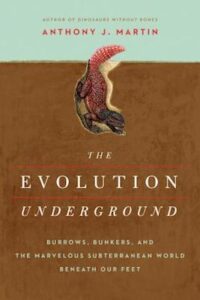We’ve all heard the old saying; whenever someone is embarrassed or fearful to the point where all hope seems lost, “I just want to crawl into a hole and die.” However when you think about it, this saying makes little sense. After all, the point is to get away from the problem, hence crawling into a hole for isolation from, and protection against, any worsening of the situation. But why die? After all, once you’re nice and safe in the aforementioned hole, the need for protection and a place to weather out whatever storm – metaphorical or otherwise – is blowing against you has been satisfied. Indeed, in such a hole, one actually has an improved chance of survival, be it physically or emotionally, therefore, as Professor Anthony J. Martin so superbly explains in his The Evolution Underground; Burrows, Bunkers, and the Marvelous Subterranean World Beneath our Feet, the more appropriate response to a threat is the exact opposite of the “crawl into a hole and die” saying; you crawl into a hole and live.
A geologist by education and an ichnologist by profession, Professor Martin devotes a considerable amount of his professional (as well as, quite likely, his personal) life to discovering and interpreting trace fossils, the records of living organisms preserved in rocks. Not to be confused with ichthyology, the study of fishes (which I’m not ashamed to admit I did upon first encountering the word), ichnology is a sub-discipline of paleontology – hence the focus on fossils.
Throughout the book, Professor Martin is guided by a central question – what causes, and has caused, various creatures throughout the planet’s history to go underground in pursuit of food, shelter, sometimes water, and in times of global catastrophe even breathable air, and what effects on the larger ecosystem have these burrowing habits caused – however he by no means confines himself to discussions of long-since extinct creatures. Indeed, judging from the delight he clearly took in filling The Evolution Underground with the wide range of creatures – both present day and as far back as the Ediacaran – whose burrowing habits he unearths (sorry…), it’s difficult to believe that he could be easily confined at all.
And it is this very unconfined curiosity coupled with his unbridled enthusiasm that makes The Evolution Underground such an enjoyable book to read. For while Professor Martin begins with the burrowing habits of alligators and then forays into the excavations – some successful, others not-so-much – of some odd little primates with a penchant for self-destructive behavior, he really begins to make his case in earnest with his chapter on present-day gopher tortoises and how their burrowing provides them not only with all the necessary comforts, but also creates miniature underground ecosystems for a surprisingly large collection of flora and fauna.
Professor Martin uses this tortoise chapter, and a slightly later one recounting the life of a (hypothetical) individual Lystrosaurus, to lay out a number of key ecological concepts to which he will return many times over and again; discussions of everything from the Ediacaran biota to the lobsters in the surf-and-turf special at your local eatery; each time, like the superb teacher he clearly is, gently reinforcing important points to his readers with subtle (and not-so-subtle) jests to ensure they’ve been paying attention.
But paying attention is not in the least difficult whilst reading this book. Indeed, as a work of popular natural history, The Evolution Underground is as delightful to read as it is informative about its subject. Professor Martin writes with an easy-going, friendly and conversant style that is filled with a wealth of interesting facts lovingly woven together with cleaver turns of phrase, wry observations, and droll puns. No scientific concept is introduced without being clearly and appropriately explained, nor anything else left unclear so as to leave the reader perplexed. Indeed, at the conclusion of the main text itself, he has included an appendix documenting every genera and species mentioned in the book, as well as eighty-six pages of chapter-and-page cited notes that are as lively to read in-and-of themselves as the principle content of the book.
The Evolution Underground should find its way onto the reading tables and bookshelves of every naturalist, regardless of their specific areas of interest, for within its pages is both an encyclopedia of discrete facts as well as a collection of some of the best explanations of a number of core ecological concepts that I’ve found anywhere. After reading this book, every terrestrial divot, depression, and hole you see will elicit a whole range of questions about their origins, forms, purposes, and effects. Creatures perhaps formerly understood as lowly will suddenly be seen as significant. Entire forms of life, indeed, entire periods of time, of which you may not have been previously aware will swirl through your mind, impelling you to seek out further information about them. I give it my highest recommendation; I really think you’ll dig it.
 Title: The Evolution Underground; Burrows, Bunkers, and the Marvelous Subterranean World Beneath our Feet
Title: The Evolution Underground; Burrows, Bunkers, and the Marvelous Subterranean World Beneath our Feet
Author: Anthony J. Martin
Publisher: Pegasus Books
Format: Hardcover
Pages: 405 pp., many color photos and illustrations
ISBN: 9781681773124
Published; February 2017
In accordance with Federal Trade Commission 16 CFR Part 255, it is disclosed that the copy of the book read in order to produce this review was provided gratis to the reviewer by the publisher.
Available from:
If you enjoyed reading this, please consider signing up for The Well-read Naturalist's newsletter. You'll receive a helpful list of recently published reviews, short essays, and notes about books in your e-mail inbox once each fortnight.

